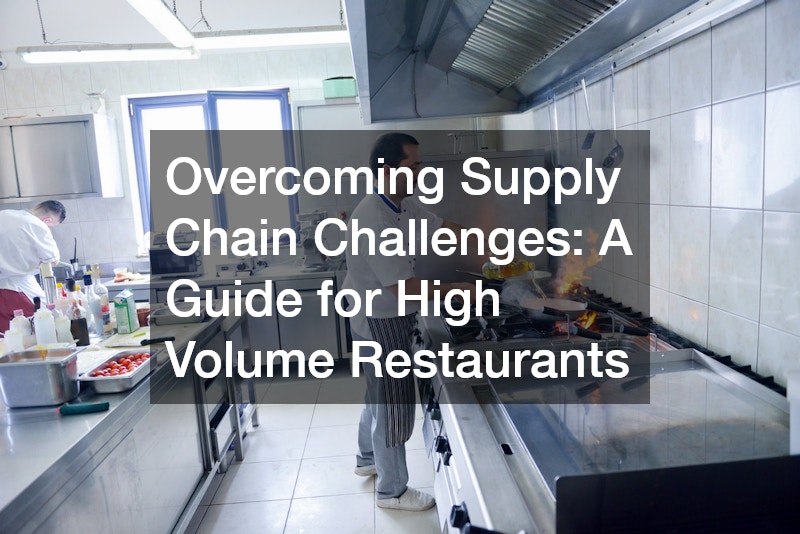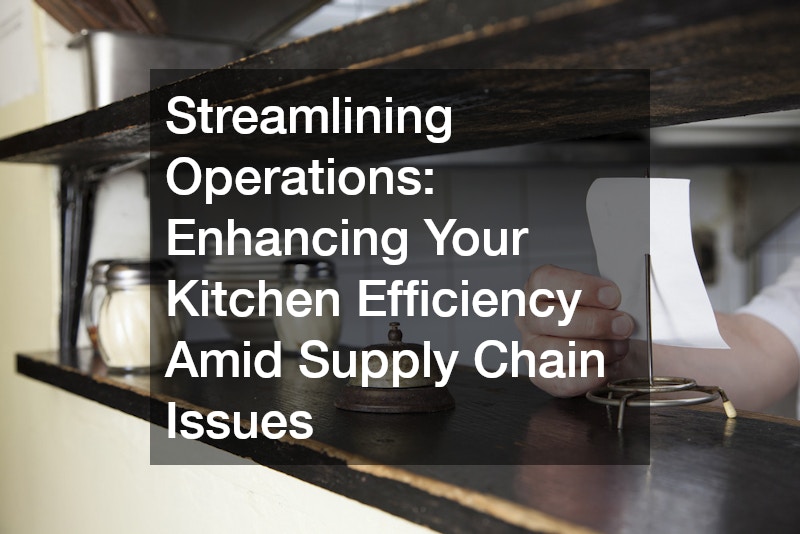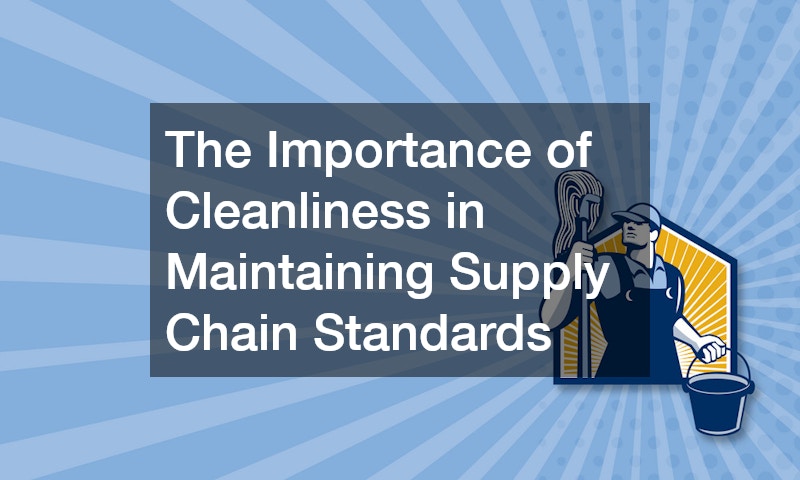

In today’s fast-paced foodservice industry, running a high volume restaurant presents unique challenges, particularly regarding supply chain efficiency. The ability to manage operations seamlessly while navigating supply chain issues has become a critical factor for success. This article explores the various strategies and considerations that high volume restaurants can employ to streamline operations and maintain efficiency amid supply chain disruptions.
Efficient supply chain management ensures that a high volume restaurant can consistently deliver quality and timely services to its customers. As supply chain issues have become more prevalent, it is essential to examine how restaurant infrastructure, operations, and logistics can be optimized for better performance. Through understanding key operational components, restaurant owners can mitigate risks and enhance their ability to serve their clientele effectively.
From maintaining cleanliness and hygiene standards to leveraging infrastructure upgrades, this article outlines how high volume restaurants can build resilience. It also highlights the role of aesthetics in customer experience and explores collaboration with industry experts to ensure quality and safety. Ultimately, optimizing storage solutions and embracing technology are vital steps in achieving supply chain success.
Streamlining Operations: Enhancing Your Kitchen Efficiency Amid Supply Chain Issues

For a high volume restaurant, streamlining kitchen operations is pivotal for minimizing the impact of supply chain disruptions. This involves optimizing all aspects of the commercial kitchen workspace, from workflow design to equipment placement. Implementing smart design choices can facilitate faster food preparation and a more agile response to inventory fluctuations.
A well-organized kitchen can drastically reduce wait times and enhance customer satisfaction. By incorporating local cabinet installations, restaurants can improve storage efficiency and ensure that ingredients are easily accessible. Moreover, using commercial wall installations can aid in better organization and segmentation of kitchen areas, thereby reducing congestion and enhancing overall efficiency.
Kitchens in high volume restaurants also benefit from technological advancements that enhance day-to-day operations. Investing in digital inventory management and scheduling tools can assist in real-time tracking and forecasting demands, reducing the burden of sudden supply chain challenges. By staying ahead with digital solutions, restaurants can better navigate unforeseen disruptions in their supply chains.
The Importance of Cleanliness in Maintaining Supply Chain Standards

A high volume restaurant must prioritize cleanliness to maintain supply chain standards and regulatory compliance. Ensuring hygiene can prevent contamination and expedite supply chain processes by building trust with suppliers and customers. Regular janitor cleaning services can play a significant role in maintaining an immaculate kitchen environment.
Effective sanitation practices not only focus on food preparation areas but also extend to storage and waste management. Utilizing specialized pest control contractors can safeguard against infestations that might otherwise lead to significant food supply disruption. High standards of cleanliness also help in upholding brand reputation and fostering customer loyalty.
Moreover, when cleanliness is prioritized, a high volume restaurant can significantly reduce waste and spoilage. Proper waste disposal services are crucial in this regard, ensuring that waste is managed efficiently and sustainably. Maintaining a clean kitchen supports operational efficiency by reducing downtime due to health inspectors’ interventions or staff illnesses.
How Infrastructure Upgrades Can Improve Logistics and Operations
Infrastructure upgrades can serve as a catalyst for improved logistics and streamlined operations in a high volume restaurant. New overhead doors, for instance, can significantly ease deliveries, providing seamless access for suppliers and ensuring faster turnaround times. These upgrades often result in enhanced operational productivity.
Restaurants are continuously evolving spaces that need flexibility to adapt to changing supply chain demands. Incorporating features like refrigerated trailer rentals offers temporary solutions to high-volume perishables without compromising on space or quality. This flexibility proves essential, particularly during peak seasons when demand for goods surges unexpectedly.
Additionally, investment in commercial kitchens designed for high efficiency can lead to decreased energy usage and reduced operational costs. Utilizing energy-efficient appliances and environmentally friendly designs contribute to a sustainable approach that aligns with modern consumer expectations. Infrastructure upgrades ultimately set the foundation for improved supply chain resilience and reduced operational hiccups.
Ensuring Reliable Waste Management: A Vital Component of Supply Chain Success
Reliable waste management is fundamental to the success of a high volume restaurant’s supply chain. The role of a waste disposal service is crucial in effectively handling the large quantity of waste generated daily, minimizing environmental impacts and regulatory issues. Proactive waste management strategies help ensure seamless kitchen operations and maintain supplier relationships.
A systematic approach to waste management involves evaluating the types and volumes of waste produced and opting for effective disposal methods. Engaging with waste management experts can provide insights into recycling, composting, and waste reduction options tailored to restaurant needs. Sustainable practices in waste management can lead to cost savings and a cleaner operational environment.
In addition to external waste disposal services, internal kitchen practices also play a significant role. Re-evaluating food preparation processes to curtail waste, such as using trimmings for stocks or sauces, promotes efficiency. High volume restaurants that embrace waste reduction not only reduce disposal costs but also position themselves as environmentally responsible establishments.
Creating a Welcoming Atmosphere: The Impact of Aesthetics on Customer Experience

The ambiance of a high volume restaurant significantly influences customer perceptions and experiences. Restaurant upholstery, interior décor, and overall aesthetics contribute to creating a welcoming atmosphere that encourages repeat patronage. A refined aesthetic is not merely decorative; it can enhance the dining experience and promote longer stay duration.
Strategically selected materials and furnishings create an inviting environment that aligns with the restaurant’s brand identity. Commercial wall designs, for instance, can help create a cohesive visual narrative that distinguishes the restaurant in a competitive market. An attractive, well-maintained space is essential for attracting new customers and retaining existing ones.
Moreover, aesthetics also contribute to operational efficiency. Well-designed interiors consider both customer comfort and staff navigation, reducing bottlenecks and improving service speed. As such, high volume restaurants must strike a balance between functionality and visual appeal to optimize both customer satisfaction and operational flow.
Building Resilience: How Your Space Can Influence Your Stability
The physical space of a high volume restaurant plays a pivotal role in building resilience against supply chain disruptions. By designing a flexible and functional layout, restaurants can readily adapt to supply shortages or demand spikes. Space planning is thus integral to achieving operational efficiency and stability.
A resilient space encourages efficient storage and usage of resources, including quick accessibility to cold storage and other critical infrastructures. This accessibility helps minimize the impact of supply chain delays on operational productivity and ensures that the restaurant can continue to meet customer expectations. Investing in versatile spatial arrangements helps buffer against unpredictabilities in the restaurant’s supply chain environment.
Moreover, resilience is not only physical but also systematic. Regular maintenance of high volume restaurant facilities is crucial to avoid interruptions. This includes the use of pest control contractors to avoid infestations that could otherwise disrupt the supply chain by contaminating food supplies and storage areas.
Collaborating with Experts to Maintain Consistent Quality and Safety
Collaboration with industry experts helps a high volume restaurant maintain consistent quality and safety across all operations. Engaging with professionals like pest control contractors and waste management services providers ensures that the restaurant meets industry standards and safety regulations. Expert collaboration reduces the risk of incidents that could potentially jeopardize operations or supply chain functions.
Quality consistency is an ongoing endeavor that involves multiple facets of a high volume restaurant’s operations, from sourcing quality ingredients to ensuring timely delivery. Establishing strong partnerships with suppliers and logistics providers ensures a reliable supply chain. This collaboration is critical during times of supply chain stress, when quick adaptations are needed.
Furthermore, infrastructure-related collaborations with experts in commercial kitchen design or cold storage solutions can assist in optimizing the restaurant space for enhanced product storage and safety. These partnerships offer competitive advantages by fostering innovation and efficiency, vital components in maintaining high standards of service and product quality.
Optimizing Storage Solutions for Perishable Goods: Best Practices

Efficient storage solutions are crucial to the success of high volume restaurants dealing with perishable goods. Investing in advanced cold storage technologies ensures that perishable items are preserved at optimal temperatures, reducing waste and spoilage. With the right storage practices, high volume restaurants can maintain inventory quality and extend the shelf life of their ingredients.
Utilizing refrigerated trailer rentals offers added flexibility and scalability for handling peak demands without sacrificing quality standards. This temporary storage solution enables high volume restaurants to adjust storage capacity based on varying order requirements throughout the year. Such adaptability aids in navigating seasonal supply chain fluctuations smoothly.
Beyond technology, the organization is key in perishable goods management. Developing standardized labeling and shelving systems within storage spaces helps track inventory quickly and prevents over-ordering. Efficient storage systems, combined with regular audits, provide a proactive approach to reducing perishable goods wastage and maintaining optimal supply levels.
Flexibility in Storage: Solutions for Seasonal Demand Fluctuations
Seasonal demand fluctuations present unique challenges for high volume restaurants, requiring flexible storage solutions. Implementing modular storage designs allows restaurants to adapt quickly to changes, ensuring efficient stock management during different seasons. Modular cold storage can prevent bottlenecks and delays, enabling effective inventory handling.
Refrigerated trailer rentals play an increasingly important role in offering temporary storage solutions that align with seasonal needs. This option provides the additional capacity needed during higher demand periods without long-term investment in permanent infrastructure. As demand subsides, restaurants can scale back, maintaining operational efficiency year-round.
Additionally, collaboration with suppliers can help synchronize ordering schedules to anticipate potential surges in demand. By working closely with suppliers, high volume restaurants can establish contingency plans that address supply chain disruptions, ensuring product availability when it is most needed. These strategies support consistent service levels during periods of fluctuating demand.
Enhancing Workflow: Smart Design Choices for Kitchen Efficiency
Optimizing the workflow within a commercial kitchen is vital for a high volume restaurant to maintain efficiency. By adopting smart design choices, restaurants can improve staff productivity and reduce waste. Elements such as efficient layout planning and strategic positioning of kitchen stations contribute to streamlined operations.
In the context of a high volume restaurant, an open kitchen layout can boost communication and coordination among team members. This layout style also allows chefs to adjust to fluctuating demands quickly, delivering consistent quality to patrons. Efficiently planned kitchens facilitate the smooth flow of ingredients from cold storage to preparation areas, thus maintaining a swift service pace.
Lighting, ventilation, and ease of access further influence workflow efficiency. Proper commercial wall and ceiling installations enhance visibility and reduce fatigue, contributing to safer and more efficient workspaces. High volume restaurants benefit from these design elements that improve kitchen workflows, resulting in increased staff morale and customer satisfaction.
Learning from Challenges: Strategies for Navigating Supply Chain Disruptions
Supply chain disruptions are an inevitable reality for high volume restaurants. Learning from past challenges can help businesses create robust strategies to mitigate future risks. Conducting thorough reviews of previous disruptions offers valuable insights into vulnerabilities and areas for improvement.
Building strong relationships with suppliers and logistics partners plays a crucial role in determining supply chain resilience. By diversifying supply sources and maintaining open communication channels, restaurants can strategically manage shortages or delays. Establishing contingency plans and flexible workflows allows restaurants to adapt swiftly to unforeseen challenges.
Embracing a culture of adaptability within the organization is key to successfully navigating disruptions. Training staff to handle abrupt changes and encouraging cross-functional collaboration can ensure uninterrupted operations. High volume restaurants that maintain a proactive stance toward change are better positioned to implement successful resolution strategies during disruptions.
Adapting to Change: Year-Round Strategies for Supply Chain Resilience
Year-round resilience in the face of supply chain changes requires that high volume restaurants adopt proactive strategies. One effective approach is conducting regular assessments of supply chain processes to identify areas of improvement and prevent potential disruptions. These reviews facilitate strategic planning that supports restaurant sustainability.
Advancements in technology and data analytics have equipped high volume restaurants with tools to predict and respond to supply chain shifts proactively. A reliance on data-driven decisions allows for precision in inventory, staffing, and resource management, enhancing overall efficiency. Restaurants that regularly leverage data ensure smoother transitions amidst changing supply chain environments.
Furthermore, building a strong organizational culture that prioritizes innovation and resourcefulness aids restaurants in swiftly adjusting to industry developments. Encouraging continuous education and skill-building within restaurant teams empowers staff to champion change and approach challenges with creativity and agility. High volume restaurants that commit to year-round strategies for resilience remain robust amid fluctuating market dynamics.
Embracing Technology: Tools for Better Supply Chain Management in Restaurants
The integration of technology in supply chain management practices is essential for high volume restaurant efficiency. Digital tools streamline operations by offering precise inventory management, reducing waste, and optimizing ordering processes. Advanced point-of-sale systems, for example, facilitate detailed tracking of ingredient usage and sales trends.
High volume restaurants can leverage technology such as automated procurement systems to keep real-time track of supply levels and vendor communications. These systems streamline ordering processes and prevent stockouts, ensuring consistent product availability. By investing in innovative technologies, restaurants can maintain a seamless supply chain that supports operational excellence.
Furthermore, the adoption of IoT devices and data analytics allows restaurants to improve forecasting methods and optimize resource allocation. IoT solutions offer real-time monitoring of equipment health and operational environments, minimizing downtime and maximizing efficiency. Embracing technology empowers restaurants with the agility needed to sustain consistent service levels amidst dynamic supply chain conditions.
In conclusion, high volume restaurants face a dynamic landscape in which supply chain efficiency plays a pivotal role. By adopting strategic measures such as upgrading infrastructure, optimizing kitchen design, and embracing technology, these establishments can navigate supply chain challenges effectively. Resilient practices, supported by industry collaboration and expert insights, ensure that high volume restaurants continue to provide exceptional customer experiences.
From cleanliness standards and storage solutions to fostering a welcoming atmosphere, high volume restaurants must balance operational efficiency with customer satisfaction. Forward-thinking approaches to waste management, aesthetic enhancements, and adaptability enable restaurants to thrive in an ever-evolving market. Commitment to innovation and resourcefulness establishes a strong foundation for sustainable growth and supply chain resilience.
Ultimately, embracing new opportunities, learning from past challenges, and fostering a culture of adaptability will position high volume restaurants to succeed amidst supply chain complexities. By leveraging the strategies discussed in this article, these establishments can enhance their operational efficiency, ensuring long-term success and customer loyalty.



